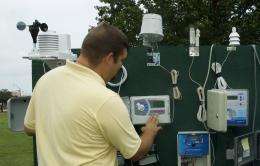Only a few 'smart' irrigation controllers were able to deal with drought

Only a few “smart” irrigation controllers performed well during the 2011 drought, according to Texas AgriLife Extension Service experts.
“The controllers are still inconsistent,” said Dr. Guy Fipps, AgriLife Extension irrigation engineer, College Station.
Fipps and Charles Swanson, an AgriLife Extension landscape irrigation specialist, tested nine commercial smart controllers during a 152-day period at College Station sites, from April through November during the 2011 drought.
The tests were the fifth year of evaluations of the controllers, which either download landscape water requirements from off-site service providers or use on-site sensors to calculate it themselves, Swanson explained. The data is then used to determine site-specific watering requirements and to operate the irrigation system automatically.
Ordinary “dumb” controllers rely on user-set timers to operate the irrigation system. When they are not set properly or run-times are not changed based on seasonal water needs, they are “notorious” for over-applying and thereby wasting water, Fipps said. Smart controllers often do better than dumb controllers, but from the tests, not all smart controllers performed the same.
During the 2011 drought, the College Station test site had less than 5.5 inches of rainfall in 2011 compared to 18 inches in 2010 and 14 inches in 2009. The 2011 drought was accompanied by unusually high temperatures and wind, so it was a good test of the controllers’ performance during a drought, he said.
“No single controller was consistently able to provide the correct amount of water for all six zones tested during all seasons,” Fipps said. “During the drought, evapotranspiration was 30 to 50 percent higher than average years. Some controllers did not adjust to the extreme conditions and applied inadequate amounts.”
However, a few controllers were able to meet plant water requirements for some and/or most of the six zones, he added.
All controllers were tested for six different virtual landscaped zones. The zones
were designed to represent common Texas landscapes and included various soil types, plant types and both shallow- and deep-root depths. The plants included turf, flowers, ground cover and shrubs.
“Programming some smart controllers for this virtual landscape was difficult, as only two controllers had programming options to set all the required parameters defining the landscape,” Fipps said. “Perhaps this is the source of some of the performance problems we saw.”
“Thus, we programmed the controllers to match the virtual landscape as closely as possible,” Swanson said. “Manufacturers were given the opportunity to review the programming, which two did. Five of the remaining manufacturers provided to us written recommendations/instructions for station programming, and one manufacturer trusted our judgment in controller programming.”
For the purposes of the test, the evapotranspiration data came from a scientific weather station at the Texas A&M University Golf Course in College Station, which is a part of the TexasET Network. The weather station was from about 0.5 to 1 mile from the tests sites, according to Swanson.
The College Station weather station on the TexasET Network site can be accessed at TexasET.tamu.edu .
Three of the smart controllers retrieved evapotranspiration data by pager. The other six controllers were sensor-equipped, but the number and type of their sensors varied, measuring different combinations of temperature, solar radiation, relative humidity and rainfall.
More results:
– During the drought, evapotranspiration was 30-50 percent higher than average years. Some controllers did not adjust to the extreme conditions and applied inadequate amounts.
– Two of the nine controllers consistently applied excessive water, nearly twice what plants required.
– For all seasons combined, the controllers provided proper amounts of irrigation 37 percent of the time, 35 percent showed excessive irrigation amounts and 28 percent irrigated inadequately.
– Four controllers provided proper amounts of water for five zones for one or more seasons.
Fipps emphasized that in 2011, they saw no consistency between the performance of controllers with on-site sensors and those that retrieved evapotranspiration data from a remote site. The big problem in 2011 seemed to be that controllers could not handle the extreme heat and drought conditions.
He also noted, that as a result of the 2011 tests, three manufacturers upgraded their units for the 2012 tests. He expects the smart controllers to continue to get smarter, which could contribute to urban water conservation.
“Some Texas cities and water utilities are now mandating smart controllers,” Swanson said. “If these controllers are to become requirements across the state, then it is important that they continue to be evaluated formally under Texas conditions.”
Fipps’ and Swanson’s full report on the 2011 tests can be found at the Irrigation technology website at itc.tamu.edu/ . Select “Smart Controller Evaluation” on the left side of the screen under “Projects.” Reports on the previous four years of tests may also be found there.
Provided by Texas A&M University



















